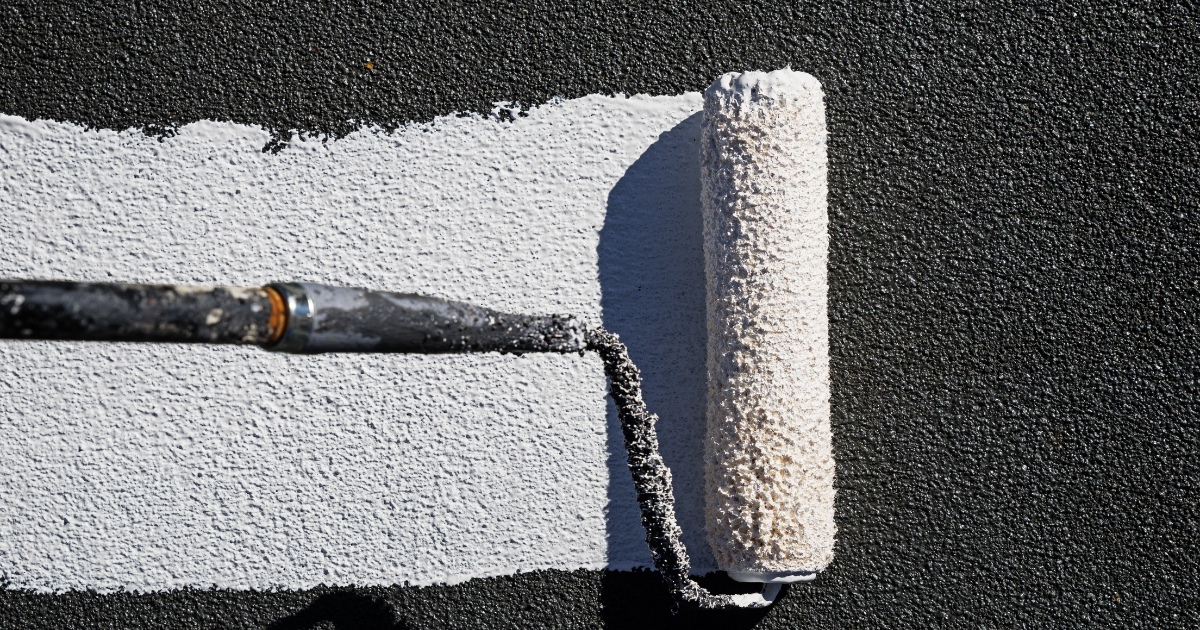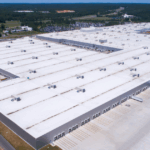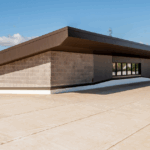
It’s true: the heat is costing your building more than you think. And higher energy bills, faster degradation, and overloaded HVAC systems are just the start. It’s undeniable that commercial properties face heat challenges that suburban and rural structures rarely experience, like dense clusters of concrete, asphalt, and glass that trap heat throughout the day. On top of that, rooftops absorb intense sunlight, nearby business facilities reflect radiant heat, and limited airflow between structures prevents cooling at night. The result is a heat load that punishes your building year-round.
That’s where cool roof systems come in. Designed to reflect more sunlight and absorb less heat, they can significantly reduce rooftop temperatures and the indoor ones beneath them. But many building owners hesitate – is the investment worth it? Will it disrupt daily operations? And what are the real results?
In this guide, we answer all these questions with data, strategy, and clarity. Let’s explore what makes these systems a smart, scalable solution for energy-conscious buildings to reduce heat without a full roof replacement.
Understanding Urban Heat Challenges
As cities continue to grow denser and hotter, building owners can’t afford to treat roofing as an afterthought, especially because their facilities face an added layer of climate stress – the urban heat island (UHI) effect. This phenomenon happens where densely built environments become significantly warmer than surrounding rural areas. The primary culprits are heat-absorbing surfaces like black rooftops, asphalt parking lots, and glass-heavy facades, all of which trap solar radiation and slowly release it throughout the night.
The Energy Cost of Urban Heat
The UHI effect can significantly drive up building energy use, especially during summer months. That means HVAC systems must work harder and longer, often during peak demand hours, when utility rates are highest. This issue goes beyond higher bills – it also causes greater wear and tear on critical systems, reduced tenant comfort, and lower energy efficiency scores.
How Cool Roof Systems Help
There’s a smart way to fight back against the UHI effect. By improving how your roof handles solar exposure, it can deliver both internal and external benefits:
1. Lower Rooftop Surface Temperatures
Cool roof systems are engineered to reflect sunlight and radiate absorbed heat more effectively. This significantly lowers the temperature of indoor environments directly beneath them, which is especially valuable for top-floor tenants or equipment rooms.
2. Improved HVAC Efficiency and Lifespan
By reducing rooftop heat gain, cool roofs ease the burden on HVAC systems. Units operate more efficiently, consume less energy, and last longer due to reduced runtime and thermal strain. In return, this leads to lower maintenance costs and deferred capital replacement.
3. Neighborhood-Scale Environmental Benefits
Cool roofs benefit your building AND help the community. By collectively reducing surface temperatures, these systems can improve urban air quality, reduce smog formation, and even lower surrounding ambient temperatures. In dense city zones, this has a measurable impact on public health and energy infrastructure resilience.
“Cool roofing is a functional upgrade that directly improves building performance in high-heat zones.” – Rick Dodaj, Founder of Silicoat Roofing.

But What Makes a Roof Cool?
Not every light-colored or reflective roof qualifies as a cool roof. To be effective, it must be engineered for high solar reflectance and thermal emittance.
Essential Attributes
When evaluating roofing systems for commercial buildings, several performance factors must be considered. These attributes determine how well the roof can reduce temperatures, improve energy efficiency, and withstand the demands of a city environment.
1. Solar Reflectance Index (SRI)
The SRI measures a material’s ability to reflect sunlight and release absorbed heat. The higher it is, the cooler the surface stays under the sun.
- A high SRI significantly reduces rooftop temperature, which in turn lowers indoor cooling loads and helps mitigate urban heat island effects.
- ENERGY STAR certified roofing materials typically require an SRI of 65 or higher for flat roofs.
2. Thermal Emittance
Even if a material reflects sunlight well, it still absorbs some heat. Thermal emittance measures how efficiently a surface can radiate absorbed heat away from itself.
- High thermal emittance ensures that absorbed heat doesn’t linger, helping the roof cool down quickly after sunset.
- Faster rooftop cooling is critical in cities where heat builds up during the day and lingers into the night.
3. Durability and Flexibility
Urban rooftops endure more wear than their suburban counterparts. A durable, flexible material reduces long-term repair costs and extends the roof’s service life. A solid cool roof system must be able to withstand:
- Foot traffic from maintenance personnel
- Heavy rooftop equipment like HVAC systems or solar panels
- Thermal expansion and contraction due to temperature swings
- Stormwater exposure from frequent rain or snow events
Common Material Options
Cool roofing isn’t one-size-fits-all. The best material depends on your building’s structure, climate exposure, and retrofit goals. Here are the most commonly used materials in commercial applications:
Silicone Roof Coatings
This is an excellent choice for commercial roof restoration projects, especially when a full tear-off isn’t feasible. These coatings offer high solar reflectivity, helping to reduce rooftop temperatures and interior cooling loads. Their strong waterproofing capabilities make them ideal for flat roofs prone to ponding water, and they provide outstanding resistance to UV degradation over time. Silicone coatings are particularly well-suited for older flat roofs that need a performance upgrade without the disruption of a complete roof replacement.
White TPO and PVC Membranes
These single-ply systems are specifically engineered for energy efficiency in commercial applications. Their naturally reflective white surfaces bounce sunlight away from the building, while the materials themselves resist punctures, tears, and chemical exposure – key for rooftops supporting HVAC units or solar panels. Welded seams play a critical role in preventing water damage in commercial roofs, especially in flat or low-slope installations. These membranes offer a durable solution for long-term performance and are best suited for new construction or full replacement projects on large-scale commercial properties.
Reflective Asphalt Shingles
While traditionally found in residential roofing, they are becoming increasingly popular in mixed-use developments and smaller commercial buildings. Their familiar appearance appeals to developers working in transitional or historic districts, and they are now available in lighter, heat-reflective colors that meet cool roofing standards. This reflective roof coating for commercial buildings offers a practical solution for structures with sloped roofs or where aesthetic alignment with surrounding architecture is important.
Practical Benefits and Tradeoffs
Cool roofs are powerful tools in managing energy costs and urban heat, but they’re not automatically the right choice for every property. Instead of asking “Should I install one?” the better question is: “What does my building actually need?”
Start with the Building Itself
Before jumping to materials or installation plans, look at your building’s structure and use. Does it have a flat roof that traps heat? Is it located in a city zone with minimal shade or airflow? Are top-floor tenants complaining about indoor temperatures? These signs point to a strong case for a reflective system, but conditions like heavy foot traffic, complex equipment setups, or moisture-prone regions might influence which type of cool roof works best.
Consider Your Operational Goals
Think beyond energy savings. Are you aiming to lower your building’s carbon footprint? Seeking to extend the life of an aging roof without a full replacement? Trying to meet local green building codes or qualify for incentive programs? Cool roofing systems can help with all of these, but only if they’re matched correctly to your priorities.
Upfront Investment
Cool roofs typically cost more upfront than standard roofing systems, but they offer long-term savings through lower energy bills, extended roof life, and fewer repairs. The key is choosing a system that fits your building’s needs and budget.
At Silicoat Roofing, we approach cool roof design with this big-picture thinking in mind. We evaluate the technical details and the long-term outcomes, helping you choose a system that cools your space while supporting your property’s value, compliance, and sustainability strategy.

Choosing the Right System
Remember: no two buildings are alike. It’s crucial for commercial property owners and facility managers to evaluate the right system based on building usage and occupancy patterns, current roof material and condition, solar exposure and shading factors, local climate and rainfall patterns, and budget and installation timeline.
Our team ensures that every cool roof installation aligns with your performance goals, whether that’s lowering cooling costs, qualifying for energy rebates, or enhancing long-term durability. We provide a process that ensures your roof performs long after the coating dries.
Step 1: Site Evaluation
We inspect your existing roof for compatibility, condition, slope, and exposure. Urban buildings often have complex setups with mechanical units, foot traffic zones, and drainage challenges that need careful planning.
Step 2: System Design
Based on your goals (energy savings, sustainability, maintenance reduction), we recommend the appropriate cool roofing system, whether it’s a silicone coating retrofit or a full membrane replacement.
Step 3: Expert Application
Our trained crews install each part of the roofing system according to manufacturer guidelines, using only approved materials. We also coordinate the work schedule to avoid interrupting your business operations.
Step 4: Post-Installation Support
Cool roof systems are long-term investments. That’s why we offer ongoing support through proactive roof maintenance and reinspection programs to keep your roof performing as promised.
Common Questions About Cool Roofs Systems
How long does it take to install a cool roof system?
It depends on the roof size and system type. We can give you a more detailed timeline during our assessment.
Do cool roofs only work in hot climates?
No. While most beneficial in warm regions, they also help reduce thermal cycling in moderate climates, preserving roof materials.
Will a cool roof system qualify my building for energy rebates?
In many cases, yes. Cool roofs may be eligible for local or state-level incentives. Silicoat can help identify rebate programs in your area.
A Smart Move in a Hot Market
The rising heat in cities isn’t going away. Commercial property owners who invest in cool roof systems now position their buildings to handle future challenges with lower energy use, better tenant comfort, and increased asset longevity.
Silicoat Roofing brings deep experience in urban cooling roofs and energy-efficient technologies. Whether you’re retrofitting an aging flat roof or designing a new energy-smart facility, we’re here to help.
Ready to explore a heat-reducing roof solution that fits your building and your budget? Contact us for a customized cool roof evaluation today. Let’s talk about a solution tailored to your building, budget, and goals.
About the Author
Rick Dodaj is the founder and CEO of Silicoat Roofing, specializing in commercial roofing solutions that protect businesses and their investments. With extensive experience in commercial roofing, Rick leads a team dedicated to providing cost-effective, long-lasting roofing solutions. Connect with him on LinkedIn to learn more about commercial roof maintenance and protection strategies.


 Previous Post
Previous Post Next Post
Next Post